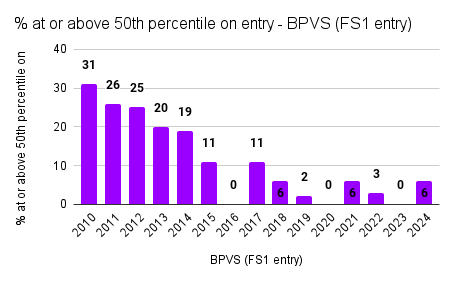Data
Context
The complexity of need is high. Almost 70% of children are entitled to Pupil Premium. Many children are disadvantaged through more than one indicator. A child is more likely to be FSM and SEND and also receiving support through social services, multi-agency or school pastoral teams whilst living in significantly challenging circumstances than not.
When compared to starting point on entry to Foundation Stage our children's progress is good.
How well are children achieving when they enter the school?
The British Picture Vocabulary Score is an assessment of children’s language on entry to the school in Foundation Stage. Language deprivation is increasing for cohorts entering the school with the vast majority of pupils significantly below their age expected when they arrive. The expected centile for a child is 50.
- 2023/24 BPVS data shows:
- 2 children were assessed at 50th+ centile, 6% of the cohort (ARE+)
- 51% of the cohort achieved an age standardised score placing them at less than the 10th centile. The percentage of children achieving in the lowest 10% continues to increase overtime. (44% in 2022/23)
- 37% of the cohort entered at the 1st centile, the lowest possible starting point.
How well do children in Y1 achieve?
- 72% of pupils passed Phonics Screening Check. 77% excluding 2 pupils in the IRU.
- There has been significant increases in outcomes since 2016 to 2024 of +29% achieving a pass.
- 70% of disadvantage learners passed PSC
- By the end of Y2, 90% of pupils passed PSC in 2024
How well do children in Y6 achieve? (End of KS2)
|
Average Scaled Score KS2 2024
| Arbourthorne | National | |
| Reading | 101 | 105 |
| Maths | 101 | 104 |
| Grammar, Punctuation & Spelling (SPaG) | 100 | 105 |
The above figures include data of children with an allocated SEND place in the Integrated Resource Unit (Citywide Provision) for children with complex learning needs.
Performance Tables
A link to the DfE school performance tables website:



























































